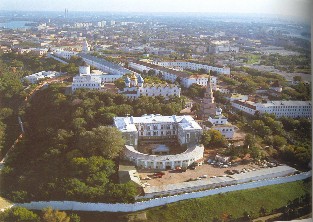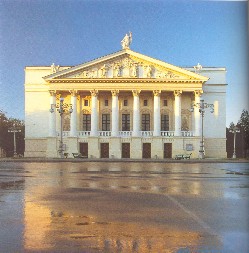|
| ||||
|
|
||||
|
| ||||
|
My native town
On the green expanses of Eurasia, in a region of forests, lakes, and fields cultivated from ancient times, at the confluence of the little Kazanka and the biggest European river, the Volga, stands a city that will soon have been there for a thousand years, a city with an enigmatic name and a no less mysterious, but surprising and brilliant history. This is Kazan, one of the most important industrial and cultural centres of the Volga region, in whose history from time immemorial the influences of the civilisations of East and West have fused and interwoven. Kazan, which like Rome stands on seven hills, is the capital of an ancient people and country whose names, though familiar, are shrouded in misconceptions. The people are the Kazan Tatars; the country is Tatarstan. Situated, as a result of historical circumstances, in the very heart of Russia, only eight hundred kilometres to the east of Moscow, Kazan is the capital of a multi-national republic that occupies the area between the Volga and the Ural Mountains. The Tatars have their own language, their own culture, their own age-old traditions and festivals, their own faith, but their past has been and remains intertwined with the history of Russia in the most dramatic and sometimes fateful way. The comparison with the Eternal City is not incidental, and not confined to the number of hills on which present-day Kazan extends on the left bank of the Volga. The winged snow leopard depicted on the coat of arms of the independent republic of Tatarstan is connected with a legend about an orphan whom a snow leopard found, saved from enemies and nurtured, in much the same way as a she-wolf raised Romulus and Remus, the legendary founders of Rome. The main similarity, however, is the dominant role played by Kazan and the remarkably enlightened state of the Kazan Tatars in the medieval history of Eurasia. All history is full of vicissitudes, distortions and prejudices, but there are few peoples in this world who have been the subject of so many historical misconceptions as the Kazan Tatars. The name 'Tata' or 'Tatar' originated at the start of the Middle Ages in distant China, where it was used for one of the Mongol tribes. Whether or not it is true that these Tatars were in the front ranks of the terrifying Mongol hordes under the great conqueror, Genghis Khan, in any event all the Turkic speaking tribes to the east of Old Russia who were subjugated by the Golden Horde and combined into a state by them began to be called Tatars. After its defeat by the tribes of the Great Steppe, Old Russia also started to be called 'Tartaria' in western chronicles. It is an historical fact, however, that the people who bear the name Kazan Tatars were living on the land between the rivers Volga and Kama much earlier than the invasion of Genghis Khan, and are not at all 'newcomers'. The Russian historian N. I. Vorobev wrote: ' The name Tatar (the official Russian name for the people of the Golden Horde) began to be applied to the population of the Volga-Kama region only from the time when, after the organisation of the Kazan Khanate and its brilliant victories over the Russians, the Kazan population absorbed the Tatars of the Golden Horde... The Finnic tribes who live there do not call them Tatars, but by their old name, Bolgars. Indeed, the people themselves considered "Tatar" to be an insulting nickname.' The Kazan Tatars have always kept alive the memory of their true, historical name: the Volga Bolgars. Where do the Bolgars of the Volga come from? As early as AD550, Gothic annals mention the Turkic tribes of Bolgars living to the north of the Black Sea. The powerful state of the Bolgars in the Black Sea area held out in the wars with Byzantium, but fell under the pressure of the Turkic Khazars, a vanished people, who dominated much of Eurasia in the seventh century. From the descendants of these tribes who went wandering over Europe came the Balkan Bulgars, the Volga Bolgars, and even the Caucasian tribes of Balkars, Kumyks and Karachaevs. The founders of modern Bulgaria, today's Tatarstan and neighbouring Chuvashia were, in the fifth to seventh century, one and the same people. Though the Balkan Bulgars, having accepted Christianity, soon lost their Turkic characteristics, none the less they preserved the old name of their country. The Kazan Tatars, on the other hand, preserved everything except their name. Such are the paradoxes of history. Many medieval historians knew of the state of the Volga Bolgars, which flourished from the ninth to twelfth centuries. Even the great English historian and philosopher Roger Bacon, in his Opus Magnum written in the second half of the thirteenth century, stated: 'Further on, beyond Etilia, the Kuman principality borders on the north with Great Bolgaria, where the Bolgars come from, who live between Constantinople, Hungary and Slavonia. Small Bolgaria is in Europe and there they speak in the language of the Bolgars who live in Great Bolgaria, which is in Asia...' Great Bolgaria of the early Middle Ages, which in the course of history became the Kazan Khanate and contemporary Tatarstan, was a powerful and developed state, trading with all the known world: Bolgar leather goods and furs reached not only the countries of the East, but also Lithuania, Poland, Italy and Flanders. The Russian historian S. M. Solovyov, who described the enlightened civilisation of the Volga Bolgars, 'a trading and industrial people', wrote: 'In times long ago, when the Russian Slavs had not yet begun to build Christian churches on the Oka and had not yet occupied these places in the name of the European citizenry, the Bolgars were already listening to the Koran on the banks of the Volga and Kama...' From the tenth century, the Volga Bolgars minted their own silver coins with Arabic inscriptions: eloquent testimony of the level of development of internal and foreign trade. The ancestors of the Kazan Tatars were the first in Europe to begin to smelt high-quality cast iron. The Bolgar towns between the rivers Volga and Kama were noted for ferrous metallurgy, pottery, gold and silver working, and the production of leather goods. In Central Asia and Iran the best leather and leather footwear is called Bolgar since that time. From the tenth century, Bolgar builders erected stone and wooden mosques, schools, palaces, caravanserais and civic buildings with central heating and plumbing systems. On the territory of Tatarstan, large towns arose: Bilyar, the second largest city of Volga Bolgaria, occupied an area of 530 hectares at a time when Kiev covered 150, Vladimir 160 and Paris 439 hectares. In 922, after direct diplomatic talks with Baghdad, Volga Bolgaria accepted Islam, and the ancient Turkic runic writing was changed to the Arabic script. Science, philosophy and literature developed. The first important written work of Bolgar literature, the immensely long poem by Kul Gali entitled Kyssai-Yusuj] is dated to 1212. The language of this major work is remarkably close to the modern literary language of the Kazan Tatars.
| ||||
|
| ||||
| Сайт создан по технологии «Конструктор сайтов e-Publish» | ||||

